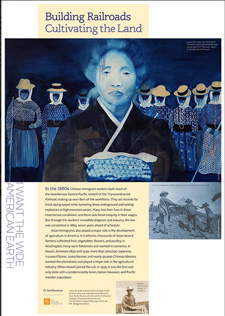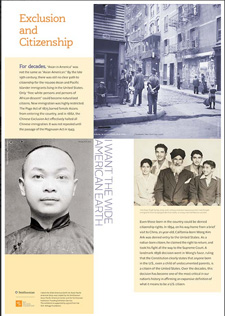The Asian-Pacific-American story has roots that reach across borders and span oceans—but the tale is quintessentially American. How we teach and learn about American history and culture must include building knowledge about the struggles, the sacrifices and the achievements of Asian-Pacific Americans. The questions below are designed to help build that knowledge in your classroom.
These questions accompany the Smithsonian’s poster series I Want the Wide American Earth. They can be used in class discussions or as prompts for writing.
Introduction: The Asian-Pacific-American Story
General Questions
- How is the Asian-Pacific-American immigrant experience similar to or different from those of other immigrant groups? How has it changed over time?
- How does immigration for any group change—generally and specifically—over time?
- How has government power been used to discriminate against Asian-Pacific Americans? Can these wrongs be rectified? How?
- How have Asian-Pacific Americans used civic engagement to improve their lives?
Poster-based Discussion Questions
- What is quintessentially American?
- What contributions and values do Asian-Pacific Americans share with other immigrants?
- What is the significance of this photo? Does it support or contradict the poem? How?
- Why does the poem speak to “the brave” and “the proud builders and workers”? How does this description in the poem relate to the Asian-Pacific-American experience?

Building Railroads, Cultivating the Land
- Who is included in the phrase “Asian, Native Hawaiian and Pacific Islander population”?
- What does “harsh inequity in their wages” mean? How can wages be equitable? What rules or principles should apply to wage equity?
- Why do you think that 80 percent of the workers building the Transcontinental Railroad were Chinese immigrant workers? Can you think of any dangerous, unpleasant and low-paying jobs today in which the majority of the workforce is a particular minority group? What factors contribute to the overrepresentation of minorities in high-risk, low-pay occupations?
- The railroad was finished significantly ahead of schedule. What factors contributed to the rate of completion?
Exclusion and Citizenship
- What is the difference between naturalization and immigration?
- Why did the U.S. Congress limit immigration from Asia and prevent Asians from becoming citizens? What does that tell you about prevailing attitudes toward Asian immigrants at the time?
- What might have been the logic behind the 1875 Page Act barring Asian women from entering the United States?
- In 1898, the U.S. Supreme Court ruled that any child born in the United States, regardless of the citizenship status of his or her parents, is an American citizen. How has this decision shaped the way citizenship is defined in the United States?
- Today debate continues about extending citizenship to certain immigrant groups in the United States. What lessons from the experiences of Asian-Pacific-American immigrants over the past century can be applied today?
Japanese Internment and Heroic Service
- Why would people designated as “enemy aliens” by the U.S. government want to serve in the U.S. military? What challenges might they have faced while serving? What does their service suggest about their values?
- On what basis were Japanese Americans judged to be a threat and interned in camps? Were the reasons given ultimately found to be legitimate? Are there circumstances under which internment should ever be considered during wartime?
- In 1988, Congress passed a law formally apologizing for the internment of Japanese Americans during World War II. The law mandated a reparations payment of $20,000 to each of the individuals interned in these years. Do you think this decision was appropriate? Explain.
- After 9/11, one of the first groups to protest racial backlash against the Muslim community was Japanese Americans. How might this be related to Japanese-American history in the United States?
Asian-American Activism
- What do Asian-Pacific Americans have in common with African Americans and Mexican Americans? How might this influence their interest in civic engagement?
- What is a “pan-ethnic” movement?
- In the 1980s, Chinese American Vincent Chin was beaten to death by autoworkers enraged over the rise of the Japanese auto industry. Can you think of a minority group today that experiences unjustified blame for the state of the U.S. economy? How are the attitudes behind the two situations similar or different?

Post-1965 Immigration
- Assess the idea of identifying Asian Americans and Pacific Islanders as a “race group.” How is that designation accurate or inaccurate? What role does the social construction of race play?
- What does it mean to have “home on both sides of the globe”?
- How has the expansion in Asian-Pacific immigration to the United States over the last several decades enriched the overall culture of the United States?
- How did the Hart-Celler Act affect immigration to the United States? How did the experience of post-1965 Asian-Pacific-American immigrants and immigrant groups differ from their predecessors?
Transforming American Food
- Preservation, adaption and ingenuity: How are these cultural values present in Asian-American cuisine?
- In what ways has American cuisine been reinvented and evolved with the addition of Asian-Pacific-Americans cultures?
- To what extent is the drive to adapt traditional Asian-Pacific food according to modern American tastes a good or a bad thing?
- Does your family have food-related traditions that have been changed or preserved?
Advances/The Journey Continues
- What is the myth? What is a disparity?
- What does it mean when Asian-Pacific Americans are called a “model minority”? How can this stereotype hurt the diverse individuals that comprise the Asian-Pacific-American population?
- Why is it significant that Asian-Pacific Americans have made such strides in science, art, business and other industries? Can you think of other examples of Asian-Pacific-American achievers in various fields?
- What changes should our country make to ensure the needs of all citizens are recognized?
Teaching and Learning Resources
Smithsonian Education: Asian Pacific American Heritage Teaching Resources includes links to a variety of curriculum guides, online resources and lesson plans to help educators teach about the histories and cultures of Asian-Pacific Americans. The website includes interdisciplinary lesson plans on the history and experiences of Korean Americans, Japanese Americans, Vietnamese Americans and other people of Asian descent. It also links to online exhibits on particular moments in Asian-Pacific-American history, such as the internment of Japanese Americans, Chinese immigration to California and the creation of the state of Hawaii. Many of the lessons focus on the experiences of young people and include primary sources written by young people.
A Century of Challenge and Change: The Filipino American Story is an interactive, multimedia curriculum that follows the lives and experiences of Marissa and Jordan, two young Filipino Americans. Students travel with the two young characters through Filipino history and culture; highlighted words link to word definitions, photographs and more detailed information about names and terms. The units also include a chance for students to “talk back to history” and share what they learned with others.
Asian Nation: Asian American History, Demographics and Issues is curated by a Vietnamese-American professor of sociology at the University of Massachusetts Amherst. The purpose of the site is to provide demographic and historical information about Asian-Pacific-American communities as well as articles and blog posts about current issues that affect these communities, such as the portrayal of Asian-Pacific Americans in the media, international adoption, assimilation and interracial dating. The site also links to primary sources.
As the site points out, two dominant stereotypes are that all Asian-Pacific Americans are the same and that all Asian-Pacific Americans are foreigners. To challenge those stereotypes, ask students to research immigration stories and timelines for various ethnic groups using the “Ethnic Groups” link on the website. The page on the history of Chinese Americans provides a useful counterpoint to the stereotype that all Asian-Pacific Americans are recent immigrants.
This subpage on socioeconomic statistics and demographics could be used to start a research project in which students investigate the differences among Asian-Pacific-American ethnic groups today. You could ask students to research the causes of differing levels of educational attainment or economic conditions between different groups of Asian-Pacific Americans.